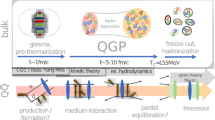Abstract
The form of the kernel that controls the dynamics of the Bethe–Salpeter equations is essential for obtaining quantitatively accurate predictions for the observable properties of hadrons. In the present work we briefly review the basic physical concepts and field-theoretic techniques employed in a first-principle derivation of a universal (process-independent) component of this kernel. This “top-down” approach combines nonperturbative ingredients obtained from lattice simulations and Dyson–Schwinger equations, and furnishes a renormalization-group invariant quark-gluon interaction strength, which is in excellent agreement with the corresponding quantity obtained from a systematic “bottom-up” treatment, where bound-state data are fitted within a well-defined truncation scheme.
Similar content being viewed by others
References
Jain P., Munczek H.J.: Q anti-q bound states in the Bethe-Salpeter formalism. Phys. Rev. D 48, 5403 (1993)
Munczek H.J.: Dynamical chiral symmetry breaking, Goldstone’s theorem and the consistency of the Schwinger-Dyson and Bethe-Salpeter equations. Phys. Rev. D 52, 4736 (1995)
Bender A., Roberts C.D., Von Smekal L.: Goldstone theorem and diquark confinement beyond rainbow ladder approximation. Phys. Lett. B 380, 7 (1996)
Maris P., Roberts C.D., Tandy P.C.: Pion mass and decay constant. Phys. Lett. B 420, 267 (1998)
Bender A., Detmold W., Roberts C.D., Thomas A.W.: Bethe-Salpeter equation and a nonperturbative quark gluon vertex. Phys. Rev. C 65, 065203 (2002)
Chang L., Roberts C.D.: Sketching the Bethe-Salpeter kernel. Phys. Rev. Lett. 103, 081601 (2009)
Fischer C.S., Williams R.: Probing the gluon self-interaction in light mesons. Phys. Rev. Lett. 103, 122001 (2009)
Eichmann, G.: Hadron Properties from QCD Bound States. arXiv:0909.0703 [hep-ph]
Eichmann G., Cloet I.C., Alkofer R., Krassnigg A., Roberts C.D.: Toward unifying the description of meson and baryon properties. Phys. Rev. C 79, 012202 (2009)
Roberts C.D., Williams A.G.: Dyson-Schwinger equations and their application to hadronic physics. Prog. Part. Nucl. Phys. 33, 477 (1994)
Maris P., Roberts C.D.: Dyson-Schwinger equations: a tool for hadron physics. Int. J. Mod. Phys. E 12, 297 (2003)
Binosi D., Chang L., Papavassiliou J., Roberts C.D.: Bridging a gap between continuum-QCD and ab initio predictions of hadron observables. Phys. Lett. B 742, 183 (2015)
Ball J.S., Chiu T.W.: Analytic properties of the vertex function in gauge theories. 1. Phys. Rev. D 22, 2550 (1980)
Ball J.S., Chiu T.W.: Analytic properties of the vertex function in gauge theories. 2. Phys. Rev. D 23, 3085 (1981)
Aguilar A.C., Binosi D., Papavassiliou J.: Indirect determination of the Kugo-Ojima function from lattice data. JHEP 0911, 066 (2009)
Binosi D., Papavassiliou J.: Pinch technique: theory and applications. Phys. Rep. 479, 1 (2009)
Abbott L.F.: The background field method beyond one loop. Nucl. Phys. B 185, 189 (1981)
Binosi D., Papavassiliou J.: Pinch technique and the Batalin-Vilkovisky formalism. Phys. Rev. D 66, 025024 (2002)
Aguilar A.C., Binosi D., Papavassiliou J.: Gluon and ghost propagators in the Landau gauge: deriving lattice results from Schwinger-Dyson equations. Phys. Rev. D 78, 025010 (2008)
Aguilar A.C., Binosi D., Papavassiliou J., Rodriguez-Quintero J.: Non-perturbative comparison of QCD effective charges. Phys. Rev. D 80, 085018 (2009)
Bogolubsky I.L., Ilgenfritz E.M., Muller-Preussker M., Sternbeck A.: Lattice gluodynamics computation of Landau gauge Green’s functions in the deep infrared. Phys. Lett. B 676, 69 (2009)
Aguilar A.C., Ibanez D., Papavassiliou J.: Ghost propagator and ghost-gluon vertex from Schwinger-Dyson equations. Phys. Rev. D 87(11), 114020 (2013)
Boucaud P., De Soto F., Leroy J.P., Le Yaouanc A., Micheli J., Pene O., Rodriguez J.-Q.: Ghost-gluon running coupling, power corrections and the determination of Lambda (MS-bar). Phys. Rev. D 79, 014508 (2009)
Cloet I.C., Roberts C.D.: Explanation and prediction of observables using continuum strong QCD. Prog. Part. Nucl. Phys. 77, 1 (2014)
Maris P., Tandy P.C.: Interaction model for the gap equation. Phys. Rev. C 60, 055214 (1999)
Qin S.X., Chang L., Liu Y.X., Roberts C.D., Wilson D.J.: Bethe-Salpeter study of vector meson masses and decay constants. Phys. Rev. C 84, 042202 (2011)
Author information
Authors and Affiliations
Corresponding author
Rights and permissions
About this article
Cite this article
Papavassiliou, J. Hadron Phenomenology from First-Principle QCD Studies. Few-Body Syst 57, 417–423 (2016). https://doi.org/10.1007/s00601-016-1065-5
Received:
Accepted:
Published:
Issue Date:
DOI: https://doi.org/10.1007/s00601-016-1065-5




